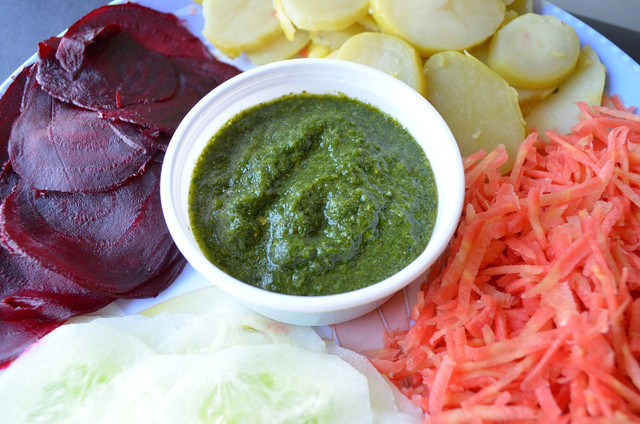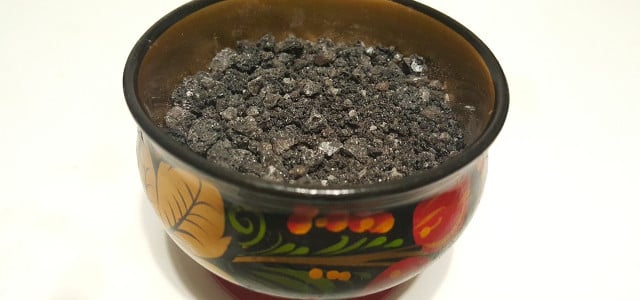What is black salt used for? Prized for its unique flavor and healthy properties, black salt is a must-have for your kitchen shelf. Here we outline exactly what black salt is, its benefits, and how you can use it when cooking.
What Is Black Salt?
Black salt is available in many specialty supermarkets, typically packaged under its Indian name Kala Namak or the more generic “Himalayan black salt”. But what is black salt and where does it come from?
Black salt has its origins on the Indian sub-continent and is mined in the mountainous regions surrounding the Himalayas. Black salt is known for its pungent sulfurous odor. Black salt gets its characteristic appearance and smell from being kiln-fired, usually for 24 hours, in a ceramic jar along with small amounts of bark and seeds cultivated from Asiatic tree species such as harad, amla, behera, and babul bark. Once cooled, the black salt is then stored and aged for sale later on.
Salt is often seen as an unhealthy addition to your diet, but is this entirely true? How Much is Too Much Salt? Symptoms and Low Salt Diet Tips
Black Salt: Health Benefits

(Foto: CC0 / Pixabay / Pexels)
Given its unique qualities, black salt boasts some surprising health benefits. These include maintaining healthy blood sugar levels, aiding with weight loss, improving circulation, and relieving muscle cramps. It is also reported to be effective in relieving heartburn, flatulence, and other digestive complaints. When applied topically – usually as an ingredient of homemade body cream or scrub – black salt can help reduce dandruff and promote healthy hair growth, correct discolored nails and deep cleanse your skin.
As with anything, however, moderation is the key and these health benefit claims are not entirely conclusive. In any case, be very careful not to overdo it and ingest too much. Black salt often contains high amounts of mineral fluoride, which could actually be damaging to your health in the long term.
Using Black Salt: Vegan Tofu Scramble



(Foto: CC0 / Pixabay / PDPics)
Black salt is often used in South Asian dishes, particularly ones from Bangladesh, India, Nepal, and Pakistan. It can be added to meals simply as its own condiment or mixed in to mouth-watering side dishes such as chaats, raitas, chutneys, fruits and salads. Black salt also has a rich umami flavor, which is a great addition to earthy vegetable broths and stews.
Given its pungent sulfurous egg-like aroma, black salt is perfect for vegans who may be craving scrambled eggs. With just a few organic ingredients and fifteen minutes of time, this vegan tofu scramble makes a hearty plant-based breakfast.
You’ll need:
- 12 oz silken tofu = 300g or approximately 1 block of silken tofu
- ½ tsp black salt
- ½ tsp turmeric powder – this will give your tofu that vibrant scrambled egg color
- ½ tsp garlic powder – or freshly chopped which is even tastier!
- ½ tsp paprika powder
- salt & pepper to taste after cooking (optional)
Heat a non-stick pan on the stove with a bit of oil on low to medium heat.
Mix your silken tofu with turmeric powder, garlic powder, and paprika powder (note: NOT your black salt). Place the mix in the pan and lightly stir occasionally, allowing it to cook evenly.
Once your tofu scrambled ‘eggs’ take on a slightly firmer texture and excess water in the pan has evaporated (this should take about 10-15 minutes), add your black salt and season with salt and pepper to taste. Then, it’s ready to serve!
Add your vegan scrambled eggs as the main ingredient of a delicious vegan breakfast burrito, or just keep it simple and serve it with some fresh bread or buns.
Read more:
- Vegan Egg Substitute: 6 Ideas for Vegan Egg Replacers
- Going Vegan: 5 Simple Steps Towards Veganism
- Vegan Honey Alternatives: 4 Plant-Based Substitutes
Do you like this post?






